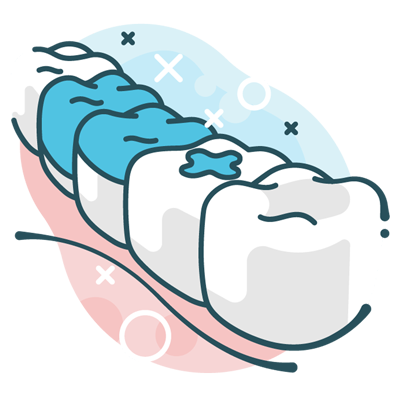Inlays and Onlays
Lab-Made Fillings
 Inlays and onlays are lab made fillings that some people refer to as “three-quarter crowns”. Their durability adds extra reinforcement when a filling isn’t appropriate, yet they’re more conservative than a full-coverage crown. Choosing an inlay or onlay is the perfect go-between for teeth that are at risk for more significant structural damage.
Inlays and onlays are lab made fillings that some people refer to as “three-quarter crowns”. Their durability adds extra reinforcement when a filling isn’t appropriate, yet they’re more conservative than a full-coverage crown. Choosing an inlay or onlay is the perfect go-between for teeth that are at risk for more significant structural damage.
The Difference Between Inlays and Onlays
As the name suggests, inlays and onlays are slight variations of the same type of restoration. The cover anywhere from 2/3-3/4 of a tooth, preserving as much healthy enamel as possible.
The difference between an inlay and an onlay is that one goes inside of the grooves and valleys of the chewing surface (inlays) while the other covers and rebuilds the cusps on the biting edges (onlays).
Most lab-made fillings are made out of ceramics such as porcelain. This design makes them blend in with the colour of your tooth and less noticeable when you smile. They’re also extremely durable.
In other instances, we’ll choose to make your inlay or onlay out of gold. Gold is ideal in areas where teeth are load-bearing, such as upper back molars. It withstands heavy pressure and grinding, making it useful for restoring teeth. If your gold inlay/onlay is on an upper back tooth, it’s usually not visible during everyday conversations.
AT Ridgeline Family Dentistry, your treatment for inlays/onlays is less like a filling and more like a crown. Since the restorations are made in a lab, we’ll need to numb, prep and impress your tooth at the first appointment. About two weeks later, your permanent restoration is ready to bond into place. In the meantime, we’ll place a temporary filling or crown over your tooth to protect it.
The bond between an inlay/onlay and your tooth is a tight one. As with crowns or fillings, it’s important to keep the margins of your restoration clean. Daily brushing and flossing will limit the risk of stain or leakage around the edges, helping it to last as long as possible. Use a non-abrasive toothpaste to prevent any surface scratches to the ceramic or your enamel.
Do You Need an Inlay or Onlay?
Request a consultation today. We’ll thoroughly examine your tooth and take an X-ray to evaluate the extent of structural damage and let you know if an inlay or onlay is right for you.
CONTACT US »

